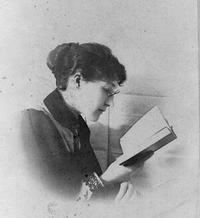Occupation Writer Name George Egerton | Role Writer Died August 12, 1945, Sussex | |
 | ||
Books Discords, Keynotes and Discords, The Wheel of God, Fantasias ‑ London (usw) - La, Symphonies ‑ Scholar's Choice E | ||
George Egerton and the Gender of Writing for ‘The Yellow Book’
In Memory of George Egerton
Mary Chavelita Dunne Bright (14 December 1859 – 12 August 1945), better known by her pen name George Egerton, (pronounced Edg'er-ton) was a New Woman writer and feminist. Egerton is widely considered to be one of the most important of the "New Woman" writers of the nineteenth century fin de siècle, although she was herself "embarrassed" by this connection in her lifetime and was opposed to the suffrage movement. She was a friend of George Bernard Shaw, Ellen Terry and J. M. Barrie.
Contents
- George Egerton and the Gender of Writing for The Yellow Book
- In Memory of George Egerton
- Life
- Literary career
- Reputation
- List of works
- References
Life
George Egerton was born Mary Chavelita Dunne in Melbourne, Australia in 1859, to a Welsh Protestant mother, Isabel George, and an Irish Catholic father, Captain John J. Dunne. The earliest years of her life were marked by migration between Australia, New Zealand and Chile, but most of her formative years were spent in and around Dublin, and Egerton was to refer to herself throughout her life as "intensely Irish". Raised Catholic, she was schooled for two years in Germany as a teenager. There, she demonstrated a talent for art and linguistics. Her ambitions to become an artist had to be shelved after the death of her mother when she was fourteen, and she trained as a nurse.
As a young adult, Egerton spent two years in New York. She later spent two years in Norway with Henry Higginson, a married man with whom she had eloped, whom she married in 1888. The marriage lasted only one year. These were formative years for her in terms of her intellectual growth and artistic development. While in Norway she immersed herself in the work of Henrik Ibsen, August Strindberg, Ola Hansson, Friedrich Nietzsche, and Knut Hamsun. Her brief romance with Hamsun served as the inspiration for her 1893 short story "Now Spring Has Come". Hamsun went on to win the Nobel prize for literature, and Egerton was the first to make Hamsun's work accessible to an English readership, with her translation of his first novel Hunger (Sult), published in 1899. A second marriage (in 1891) to minor novelist Egerton Tertius Clairmonte was the impetus for her first attempts at writing fiction – instigated by his penniless status and her desire to alleviate the boredom she felt upon her return to rural Ireland. She chose the pseudonym "George Egerton" as a tribute to both her mother, whose maiden name was "George", and to Clairmonte. Asked how to say her pen name, she told The Literary Digest it was pronounced edg'er-ton, adding "This name is pronounced this way, as far as I know by all bearers of the name in England."
Literary career
Egerton's first book of short stories, Keynotes, was published by John Lane and Elkin Mathews of the Bodley Head in 1893. This volume was so successful (and notorious) on both sides of the Atlantic that Egerton was soon being interviewed in the leading magazines of the day, and was famously lampooned in Punch. This and subsequent works had the same thematic preoccupation: a dismissal of female purity as a male construct that denies women the right to expect and experience sexual freedom and fulfilment. Keynotes was the high-water mark of Egerton's literary career. A subsequent volume of short stories, Discords, and her later efforts – including two additional short story volumes (Symphonies and Flies in Amber); two novels (Rosa Amorosa and The Wheel of God); and a book of Nietzschean parables (Fantasias) – met largely with failure. Her later incarnation as a playwright (Camilla States Her Case, 1925) and translator of plays (most notably from the French) generated only a few moderately successful productions.
Reputation
Egerton's stylistic innovations, often termed "proto-modernist" by literary scholars, and her often radical and feminist subject matter have ensured that her fiction continues to generate academic interest in America and Britain. Egerton's experimentation with form and content anticipated the high modernism of writers like James Joyce and D H Lawrence, and Egerton's The Wheel of God often reads as a sort of rudimentary template for Joyce's A Portrait of the Artist as a Young Man. Thomas Hardy acknowledged the influence of Egerton's work on his own, in particular on the construction of his "New Woman" character, Sue Bridehead, in Jude the Obscure. Holbrook Jackson credited Egerton with the first mention of Friedrich Nietzsche in English literature (she refers to Nietzsche in Keynotes in 1893, three years before the first of Nietzsche's works was translated into English).
